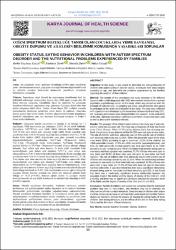Otizm spektrum bozukluğu tanısı olan çocuklarda yeme davranışı, obezite durumu ve ailelerin beslenme konusunda yaşadıkları sorunlar
Citation
Özyılmaz Kırcali B. , Demir F. N. , Demir N. , Üründü H. OTİZM SPEKTRUM BOZUKLUĞU TANISI OLAN ÇOCUKLARDA YEME DAVRANIŞI, OBEZİTE DURUMU VE AİLELERİN BESLENME KONUSUNDA YAŞADIKLARI SORUNLAR. Karya Journal of Health Science. 2022; 3(2): 50-55.Abstract
Amaç: Bu çalışmada otizm spektrum bozukluğu (OSB) tanılı çocukların
yeme davranışlarının tespiti, yaşa göre vücut ağırlıklarının değerlendirilmesi
ve ailelerin çocuğun beslenmesi konusunda yaşadıkları sorunların
belirlenmesi amaçlandı.
Yöntem: Tanımlayıcı nicel desenli bu araştırmanın örneklemini özel bir
psikiyatri-psikoterapi merkezinden hizmet alan, OSB tanılı çocuğu olan 80
farklı ebeveyn oluşturdu. Gönüllülük ilkesi ile yürütülen bu çalışmada
örneklem belirlemesi yapılmamış olup, çalışmaya katılmayı kabul eden tüm
aileler çalışmaya dâhil edildi. Veriler, Nisan-Mayıs 2021 tarihleri arasında
araştırmacılar tarafından geliştirilen anket formu ile toplandı. Araştırma
öncesi gerekli tüm izinler alındı. Verilerin değerlendirilmesinde tanımlayıcı
istatiksel yöntemlerin yanı sıra Sperman korelasyon katsayısı ve Fisher’s
Exact testleri kullanıldı.
Bulgular: Çalışmaya katılan çocukların en küçüğü 3, en büyüğü ise 13
yaşındaydı. OSB tanı konma yaş ortalaması 3.28±1.10 yıl olarak bulundu.
Çocukların %55.70’inin yeni besin tatma korkusu bulunmakta iken,
%55.70’inin yeni tatlara açık olmadığı tespit edildi. Besin seçiciliği olan
çocukların oranı %54.43 ve içecek seçiciliği olan çocukların oranı %32.91’di.
Beden kütle indeksi (BKİ) değerlerinin yaşa göre persentil karşılıkları
değerlendirildiğinde; çocuklardan %42.5’inin >95.persentil (obez),
%17.5’inin >85.persentil (fazla kilolu/şişman), %10’unun 50.persentil
(normal kilolu) ve 23.8’inin <50.persentil (normal kilonun altında) olduğu
bulundu. Yeni tatlara açık olma durumu ile besin reddi arasındaki ilişki
incelendiğinde; yeni tatlara açık olanların %72.7’si, yeni tatlara açık
olmayanların ise %84.5’inde besin reddi bulunmaktaydı. Besin seçiciliği olan
çocukların oranı %54.43 ve içecek seçiciliği olan çocukların oranı %32.91’di.
Yeni tatlara açık olma durumu ile besin seçiciliği durumu arasındaki ilişki
incelendiğinde yeni tatlara açık olanların %40.9’unda, yeni tatlara açık
olmayanların ise %75.9’unda besin seçiciliği durumu bulunmaktaydı. Yeni
tatlara açık olma durumu ile besin seçiciliği durumu arasında anlamlı düzeyde
ilişki olduğu belirlendi (p<0.05). Aile bireylerinden annenin eğitim düzeyi ile
çocuğun obezite derecesi arasında ters yönlü orta derecede anlamlı ilişki
olduğu (r= -0.53 p=0.042), babanın eğitim düzeyi ile çocuğun obezite
derecesi arasında ise çok düşük korelasyon ile anlamlı ilişki olmadığı (r=0.02
p=0.863) saptandı.
Sonuç: Otizmli çocukların ebeveynleri, beslenme sorununun yetersiz
beslenmeye yol açabileceğinden endişe duymakta ve bu nedenle beslenme
konusundaki girişimlerinin etkinliğini yoğunlaştırmaya çalışmaktadırlar.
Otizmli çocukların beslenme biçimleri ve sonuçlarının henüz tam olarak
anlaşılamaması ve aydınlatılamamış olması nedeniyle, bu çocukların yeme
alışkanlıklarını şekillendirme sürecini, yeme davranışlarını, uygulanan
diyetin günlük yeme alışkanlıkları ve besin seçiciliğinin oluşumu üzerindeki
etkilerini de içerecek ileri çalışmalara ihtiyaç duyulmaktadır. Objective: In this study, it was aimed to determine the eating behaviors of
children with autism spectrum disorder (ASD), to evaluate their body weights
according to age, and determine the problems experienced by the families
regarding the nutrition of their children.
Method: The sample of this descriptive and study consisted of 80 different
3parents with a child diagnosed with ASD who received service from a private
psychiatry-psychotherapy center. In this study, which was carried out with the
principle of voluntariness, no sampling was made, and all families who agreed
to participate in the study were included in the study. The data were collected
with a questionnaire developed by the researchers between April and May 2021.
All necessary permissions were obtained before the research. In the evaluation
of the data, Sperman correlation coefficient and Fisher's Exact tests were used
as well as descriptive statistical methods.
Results: The youngest of the children participating in the study was 3 years old,
and the oldest was 13 years old. The mean age at diagnosis of ASD was found
to be 3.28±1.10 years. While 55.70% of the children had a fear of tasting new
foods (neophobia), it was determined that 55.70% were not open to new tastes.
The rate of children with food selectivity was 54.43% and the rate of children
with beverage selectivity was 32.91%. When the percentile value of the body
mass index (BMI) according to age is examined, 42.5% of the children are
>95th percentile (obese), 17.5% are >85th percentile (overweight/obese), and
10% are 50th percentile (normal weight) and 23.8 were found to be <50th
percentile (under normal weight). When the relationship between being open to
new tastes and food rejection was examined, 72.7% of those who were open to
new tastes and 84.5% of those who were not open to new tastes had food
rejection. The rate of children with food selectivity was 54.43% and the rate of
children with beverage selectivity was 32.91%. When the relationship between
openness to new tastes and food selectivity was examined, 40.9% of those who
were open to new tastes and 75.9% of those who were not open to new tastes
had food selectivity. It was determined that there was a significant relationship
between being open to new tastes and food selectivity (p<0.05). It was found
that there was a moderately significant inverse relationship between the
education level of the mother and the degree of obesity of the child (r= -0.53
p=0.042), and there was no significant correlation between the education level
of the father and the degree of obesity of the child (r=0.02 p=0.863).
Conclusion: Parents of children with autism are concerned that the nutritional
problem may lead to malnutrition, and therefore they try to intensify the
effectiveness of their nutrition initiatives. Since the diets of children with autism
and their consequences have not yet been fully understood and clarified, further
studies are needed to include the process of shaping the eating habits of these
children, their eating behaviors, and the effects of the diet on their daily eating
habits and the formation of food selectivity
Source
Karya Journal of Health ScienceVolume
3Issue
2URI
https://dergipark.org.tr/tr/pub/kjhs/issue/72363/1057471https://hdl.handle.net/20.500.12780/711


















